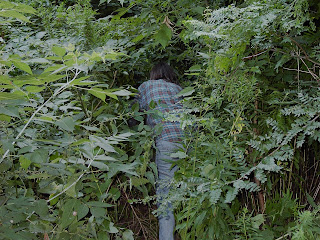
Butterflies are pollinators too































 DSV or Dog Strangling Vine also known as swallowwort is everywhere in the Don Valley and Riverdale Farm is no exception. We spent most of last week's session removing some of it from one of the slopes. For the time being, we were just pulling it and trying to remove as much of the roots as possible in the process. This method of removal will have to be repeated over several years before we can get rid of it but we're just doing what we can for now. I found an information fact sheet from the city on the subject which is very helpful to better understand the problem of invasive species.
DSV or Dog Strangling Vine also known as swallowwort is everywhere in the Don Valley and Riverdale Farm is no exception. We spent most of last week's session removing some of it from one of the slopes. For the time being, we were just pulling it and trying to remove as much of the roots as possible in the process. This method of removal will have to be repeated over several years before we can get rid of it but we're just doing what we can for now. I found an information fact sheet from the city on the subject which is very helpful to better understand the problem of invasive species.






 This is a new blog for the Riverdale Farm Community Stewardship team organized by Green Toronto. I was part of this team in 2006 and I will post items throughout the summer to talk about the various activities that will take place. Here's a sample of the kind of activities that the stewards might take part in.
This is a new blog for the Riverdale Farm Community Stewardship team organized by Green Toronto. I was part of this team in 2006 and I will post items throughout the summer to talk about the various activities that will take place. Here's a sample of the kind of activities that the stewards might take part in. In August 2006, the team took part in a monitoring session of the sanctuary pond to study the water quality of the site. The study involved taking samples from the pond and collecting insects from these samples.We worked with members of Citizens' Environment Watch, which organizes community-based ecological monitoring and stewardship programs. They use benthic inverterbrates, or "water bugs" as biological indicators to assess water quality. In order to collect these samples, we had to get into the pond wearing hip waders and using nets to try to pick up as many "bugs" as possible.
In August 2006, the team took part in a monitoring session of the sanctuary pond to study the water quality of the site. The study involved taking samples from the pond and collecting insects from these samples.We worked with members of Citizens' Environment Watch, which organizes community-based ecological monitoring and stewardship programs. They use benthic inverterbrates, or "water bugs" as biological indicators to assess water quality. In order to collect these samples, we had to get into the pond wearing hip waders and using nets to try to pick up as many "bugs" as possible.